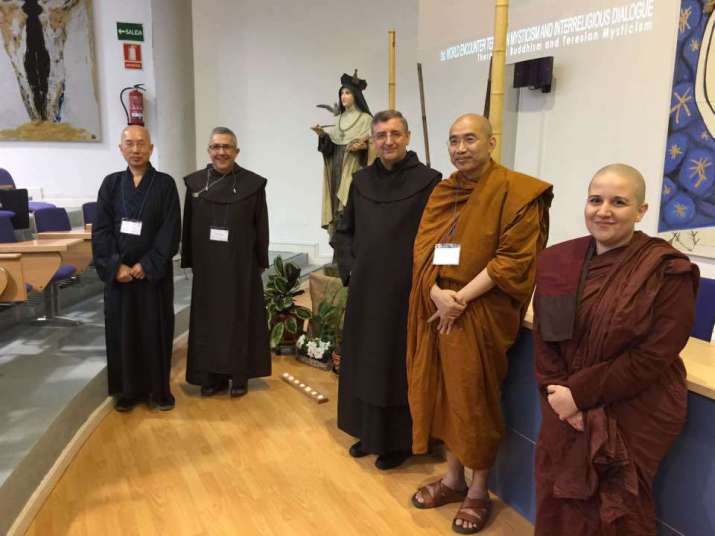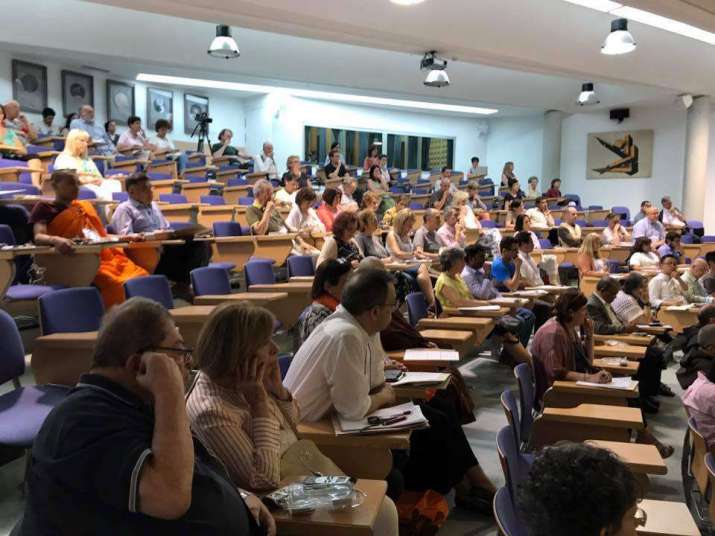NEWS
Buddhists and Carmelites Explore Interfaith Affinities at the University of Mysticism in Avila, Spain
Yesterday, the first conference between Theravada Buddhists and the Discalced Carmelite Order started, at the University of Mysticism in the medieval city of Avila. Avila is the hometown of Saint Teresa of Jesus, one of the most influential Catholic mystics and monastic reformers in the history of the Latin Church. The conference, titled: “1st World Encounter Teresian Mysticism and Interreligious Dialogue: Theravada Buddhism and Teresian Mysticism – Meditation and Contemplation, Pathways to Peace” is co-organized by the International Centre of Teresian and Sanjuanist Studies (CITeS) and the Centre of Buddhist Studies of the University of Hong Kong, and will take place from 27-30 July.
The feasibility of a dialogue between Buddhism and Teresian thought is based on the idea that both traditions turn “inwards” to uncover the true meaning of human existence and of reality, via contemplative activities like meditation that are core practices to both traditions. The “patron saints” of the conference are Saint Teresa of Avila, Saint John of the Cross, and Buddhaghosa, the author of the Visudhimagga and one of the most important Theravada Buddhist commentators.
 From left to right: Ven. Hin Hung with Dr. Francisco Javier Sancho Fermin, Fr. Agusti Borel, Ven. Dr. Khammai Dhammasami, and Ven. Dr. Dhammadinna. Image courtesy of author
From left to right: Ven. Hin Hung with Dr. Francisco Javier Sancho Fermin, Fr. Agusti Borel, Ven. Dr. Khammai Dhammasami, and Ven. Dr. Dhammadinna. Image courtesy of authorThe conference started on the 27th, with an opening speech by Dr. Father Francisco Javier Sancho Fermin, director of CITeS. “Imagine a symphony with only one note, a painting with only one color,” he said. “He who loves the different, the Other, assumes the Christian calling. Interfaith dialogue is an exercise of responsibility, or more accurately, co-responsibility. We want CITeS to be a space of encounter and little by little we’re taking significant steps, such as this conference.” In his speech, he referred to the creation of spaces to examine different aspects of mysticism, not just in the Carmelite Order but in other religious traditions as well, so that communion and fraternity between different religious traditions can be facilitated. “The simple fact is that the Order of Carmel finds its origin to be closest to the east, and is linked to the Prophet Elijah, a meeting point between different cultures and different faiths,” he stated.
His speech was complemented by a speech by Ven. Hin Hung, head of the Centre of Buddhist Studies of the University of Hong Kong, who presented the Buddhist perspective. In his speech titled “The Importance of Interreligious Dialogue and Goals for the Encounter from the Buddhist Perspective,” Ven. Hun Hung referred to the conference as the Encounter, a special meeting between Buddhists and Carmelites.
 Participants of the conference. Image courtesy of author
Participants of the conference. Image courtesy of author“In its interaction with other religious traditions, Buddhism has discovered new aspects of itself, as a result, allowing it to adapt and grow. . . . These coming days of interfaith encounter offer us many opportunities to learn from each other. We can advance our understanding of different spiritual beliefs and practices, on each [of our] own terms and without subsuming one under the other,” he said. “Differences are important, for we need to know how we differ. However, although we walk on different paths, there is a long stretch of common ground on which we can walk together. . . . This Encounter will enable us to see many of the things that are important to both religions.”*
The lectures during the conference will include Carmelite perspectives on the monastic and contemplative life, as well as a prayer and meditation workshop by Italian-born bhikkhuni Ven. Dr. Dhammadina, who is also a professor at the Dharma Drum Institute of Liberal Arts in Taiwan. On each morning of the conference , where are interreligious chants with Theravada monks who are also PhD students at the Centre of Buddhist Studies (Ven. Amritananda and Ven. Dipananda). Other speakers include Ven. Dr. Khammai Dhammasami of the University of Oxford, Dr. Rupert Gethin of the University of Bristol and president of the Pali Text Society, and influential Carmelite scholars like Dr. Maximiliano Herraiz, a CITeS professor and publisher of books about Saint Teresa of Avila and Saint John of the Cross, and Friar Augusti Borrel, definitor of the Discalced Carmelite Order.
Keep an eye out for more features and blogs by Buddhistdoor Global on this unique interfaith meeting.
* You can read Ven. Hin Hung’s speech on our blog, Tea House.
Related features from Buddhistdoor Global
Interactive Dialogue on Theravada Meditation and Carmelite Mystic Prayer in Avila
Related news from Buddhistdoor Global
Dialogue Between Theravada Buddhists and Carmelite Contemplatives to be Held in Avila, Spain
Related blogs from Buddhistdoor Global
The Importance of Interreligious Dialogue and Goals for the Encounter from the Buddhist Perspective















